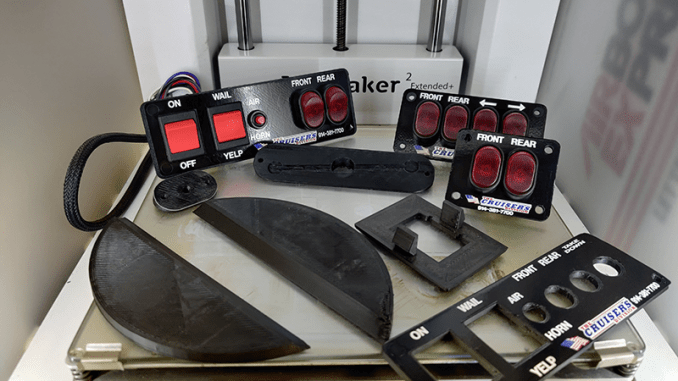3D printing has proven itself as a useful technology in critical applications for organizations like NASA producing rocket engines—and the military, 3D printing parts for aircraft. Now, law enforcement and emergency vehicles are gaining a technological boost, too, thanks to designs from Ian Gerstein. As an R&D engineer and an emergency and police vehicles upfitter, Gernstein has been using an Ultimaker 2 Extended+ to create 3D printed mounts for light heads, and customized control panels for running both lights and sirens.
One of the greatest benefits of 3D printing is the ability to innovate like never before, making parts and components that may not have been an option previously with conventional technology—as well as placing them in areas that may not have been the original intention; in fact, most of the new parts that Gerstein creates are mounted in areas that were not specified by the automobile manufacturer. Other modified parts too are made up of caps and switchplates used by police officers in unmarked vehicles.
“As vehicle manufacturers and product manufacturers constantly evolve their products, our 3D printer has proven itself useful in keeping our company current and competitive,” said Gernstein.
Evolving along with car and equipment companies is critical as they continue to refine products for improved performance. For Gernstein, the key is to keep up with such changes, collaborating—rather than competing. He has also taken advantage of the ability to create parts much more quickly, pointing out that previously he and his team were spending far more time making simple products:
“The original process was to take a sheet of ABS plastic, Dremel it into the dimensions required, cut out the switch holes, check, refit, check, refit, and after all was said and done you’d end up with a crude part you called “custom,” said Gernstein. “Since that time, we’ve been able to design a product once, press print, and walk away; the result is a professional-looking product with repeatable results and significant labor savings.”
Although some parts may have decoration or labels added later, Gernstein is able to use parts as soon as they are printed, using ABS mainly due to its temperature resistance qualities as parts may be subjected to warm interiors (and exteriors) and must be able to maintain levels below the glass transition temperature.
“As an added benefit, ABS is very cost-efficient and does not put any excessive wear on our printer,” said Gernstein.
The engineer and his team are able to create parts in just a few hours, cutting out design and waiting time traditionally expected when working with a middleman in typical manufacturing. They are also able to consider complexities for the past, present, and future in designing parts, thinking ahead regarding compatibility between vehicles—avoiding potential restrictions or problems.
[Source / Images: 3D Universe]Subscribe to Our Email Newsletter
Stay up-to-date on all the latest news from the 3D printing industry and receive information and offers from third party vendors.
You May Also Like
Precision at the Microscale: UK Researchers Advance Medical Devices with BMF’s 3D Printing Tech
University of Nottingham researchers are using Boston Micro Fabrication‘s (BMF) 3D printing technology to develop medical devices that improve compatibility with human tissue. Funded by a UK grant, this project...
3D Printing Webinar and Event Roundup: April 21, 2024
It’s another busy week of webinars and events, starting with Hannover Messe in Germany and continuing with Metalcasting Congress, Chinaplas, TechBlick’s Innovation Festival, and more. Stratasys continues its advanced training...
3D Printing Webinar and Event Roundup: March 17, 2024
It’s another busy week of webinars and events, including SALMED 2024 and AM Forum in Berlin. Stratasys continues its in-person training and is offering two webinars, ASTM is holding a...
3D Printed Micro Antenna is 15% Smaller and 6X Lighter
Horizon Microtechnologies has achieved success in creating a high-frequency D-Band horn antenna through micro 3D printing. However, this achievement did not rely solely on 3D printing; it involved a combination...
































